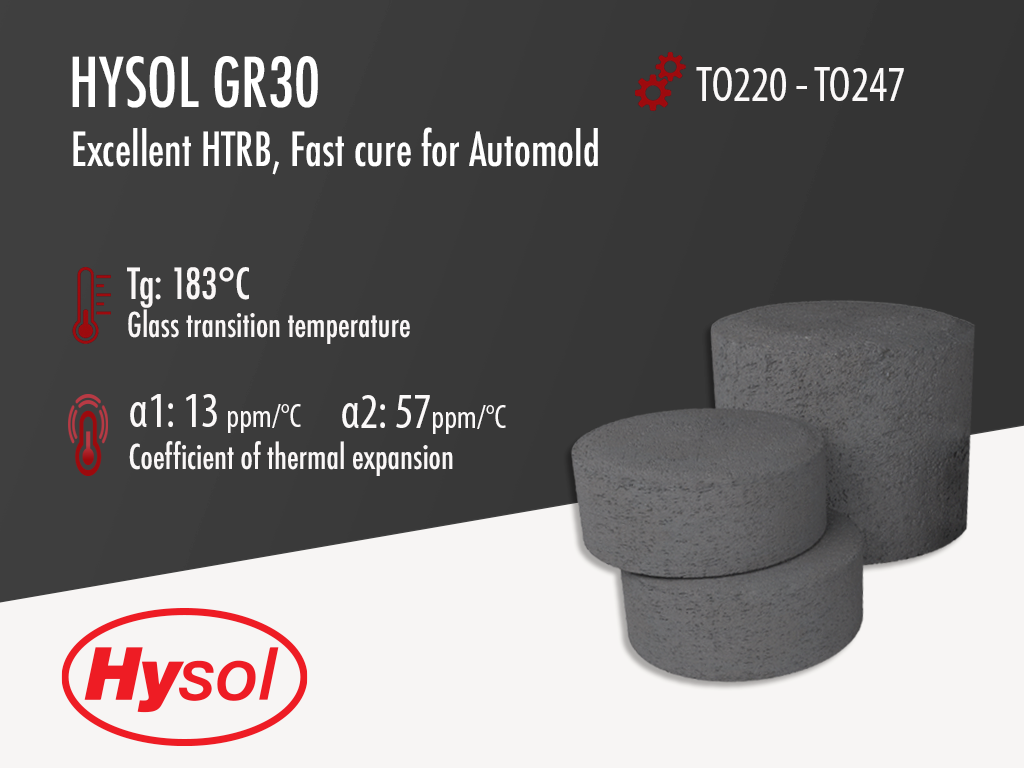Hysol GR30 | Black Epoxy Mold Compound
- Designed for TO220 & TO247
- Improved version of GR300
- Faster cycle time for Automold
Product Description
Hysol GR30 was formulated to have better electrical properties then its predecessor. This means that the GR30 passes higher levels of high temperature reverse bias (HTRB) than the standard GR300 and offers excellent HTRB performance. Additionally, it is an environmentally "Green" product, meaning that it doesn't contain any bromine, antimony or phosphorus flame retardants. Previous MG-series EMC dominated the space for power semiconductors but used halogen-containing flame retardants. This next generation epoxy mold compound replaces these older generation products. It is designed to achieve JEDEC Level 1 requirements at 260°C reflow temperature on Nickel or Nickel-plated leadframes. And to top that up, it meets UL 94 V-0 Flammability at 1/8 inch (3.18mm) thickness. This product is an alternative that can easily replace the discontinued Kyocera KE-G300S.
Technical Specifications
| General Properties | |||||||||
| Color Color The color | Black | ||||||||
| Filler Content | 81 % | ||||||||
| Specific Gravity Specific Gravity Specific gravity (SG) is the ratio of the density of a substance to the density of a reference substance; equivalently, it is the ratio of the mass of a substance to the mass of a reference substance for the same given volume. For liquids, the reference substance is almost always water (1), while for gases, it is air (1.18) at room temperature. Specific gravity is unitless. | 1.9 | ||||||||
| |||||||||
| Physical Properties | |||||||||
| Spiral Flow @ 175°C | 62 cm | ||||||||
| Chemical Properties | |||||||||
| Moisture absorption | 0.31 % | ||||||||
| Mechanical Properties | |||||||||
| |||||||||
| |||||||||
| |||||||||
| |||||||||
| Thermal Properties | |||||||||
| |||||||||
| |||||||||
| Glass Transition Temperature (Tg) Glass Transition Temperature (Tg) The glass transition temperature for organic adhesives is a temperature region where the polymers change from glassy and brittle to soft and rubbery. Increasing the temperature further continues the softening process as the viscosity drops too. Temperatures between the glass transition temperature and below the decomposition point of the adhesive are the best region for bonding. The glass-transition temperature Tg of a material characterizes the range of temperatures over which this glass transition occurs. | 183 °C | ||||||||
| Thermal Conductivity Thermal Conductivity Thermal conductivity describes the ability of a material to conduct heat. It is required by power packages in order to dissipate heat and maintain stable electrical performance. Thermal conductivity units are [W/(m K)] in the SI system and [Btu/(hr ft °F)] in the Imperial system. | 0.95 W/m.K | ||||||||
| UL 94 Rating UL 94 Rating Flammability rating classification. It determines how fast a material burns or extinguishes once it is ignited. HB: slow burning on a horizontal specimen; burning rate less than 76 mm/min for thickness less than 3 mm or burning stops before 100 mm V-2: burning stops within 30 seconds on a vertical specimen; drips of flaming particles are allowed. V-1: burning stops within 30 seconds on a vertical specimen; drips of particles allowed as long as they are not inflamed. V-0: burning stops within 10 seconds on a vertical specimen; drips of particles allowed as long as they are not inflamed. 5VB: burning stops within 60 seconds on a vertical specimen; no drips allowed; plaque specimens may develop a hole. 5VA: burning stops within 60 seconds on a vertical specimen; no drips allowed; plaque specimens may not develop a hole | V0 | ||||||||
| Curing Conditions | |||||||||
| |||||||||
| |||||||||
| Transfer Pressure | 40 - 100 kg/cm2 | ||||||||
| Transfer Time | 5 - 30 s | ||||||||
Additional Information
Designed for TO220 & TO247 devices
TO220 and TO247 are big, bulky packages, so molding these products with a standard mold compound is fairly easy without using any fine fillers. The trouble with these packages however is that epoxy mold compounds used typically fail Hig Temperature Reverse Bias (HTRB) testing, which exposes the device to humidity and temperature while the device is under BIAS. Devices often experience "gate leakage" under these conditions and fail catastrophically.
Furthermore, these devices are often used using a Nickel (Ni) leadframe, which is very difficult to adhere to. Therefore, epoxy molding compound must have a very good adhesion to Nickel to achieve MSL1 preconditioning.
GR30 can ALSO be used for Electric Vehicle Rotors
Epoxy molding compound is used to bond the magnet and rotor core by using a transfer molding method. There are several slots that go through the core. The permanent magnets are inserted in the slot and then the mold compound is filled into the gap to bind the magnet and the rotor core together.
The critical function of the material is to have a strong binding force between the magnet and the rotor core while also having a good filling capability. It should also have excellent reliability at working temperature. GR30 is a green material without Br/Sb, in compliance with ROHS that can cure fast for high Units per Hour.
Molding compounds have already been used in Rotors with Iron as a base material and with rotor working speeds up to 20000rpm and working temperatures up to ±150°C. They pass both Temperature cycling and High temperature ATF resistance tests while retaining 100% of their flexural strength and flexural modulus. This highlights the product's excellent property stability post post-automotive fluid resistance testing.



